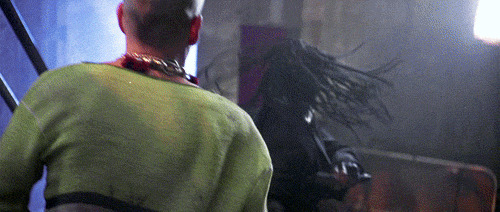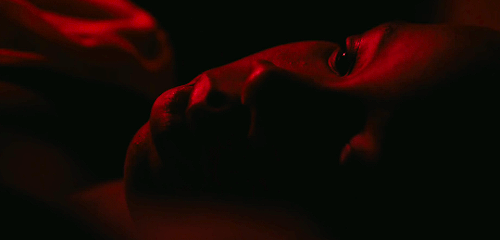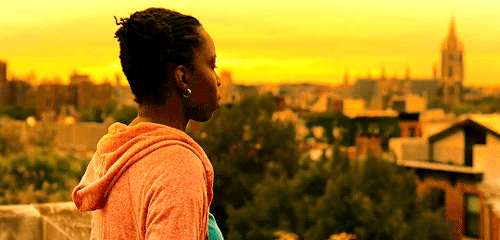Text
I agree with you that Mace is a strong and powerful individual without the help or aid of Lenny. Although the film had to throw a love interest in between the two, they worked together to solve the murder of their friend. These several different lights that are portrayed accurately.
Strange Days (1995)
Jane Gaines’s essay “White Privilege and Looking Relations: Race and Gender in Feminist Film Theory” examined the erasure of black women in cinema by white male filmmakers. To fully understand this point, Gaines relies on the history of this topic. Specifically, she states, “If, as feminists have argued, women’s sexuality evokes an unconscious terror in men, then black women’s sexuality represents a special threat to white patriarchy; the possibility of its eruption stands for the aspirations of the black race as a whole” (p. 303). In the film, Strange Days (1995),there is a strong representation of black female empowerment shown in the character of Mace. Initially playing the role of a bodyguard, Mace transforms into a powerful action hero who is constantly saving Lenny from dire situations. In one particular scene, Mace is shown cocking a gun in her holster between her thighs, held under her little black dress. The purpose of this shot is to give Mace a masculine role while still keeping her femininity intact. Tying back to Gaines’s argument, the role of a black female in this film is not to be overlooked, but rather, shown as an independent, kick-ass character. Between the love that Mace has for Lenny and her desire to keep him safe, she is represented in all different lights.

32 notes
·
View notes
Text
I agree that Lenny disregarded Mace until the very end of the film. Although she showed characteristics as a strong individual throughout the whole film, it isnt until the male gaze such as Lenny’s take attraction to her and gives her the proper attention.
Strange Days(1995)
Jane Gaines believes that when most film discusses female sexuality the attention is on white women. She goes even further to assert that the gaze is only on white female heterosexual women. This isolates a large portion of the audience who is not white nor heterosexual. By withholding characters that society can universally identify with a film narrows its reach. Gaines states “black women’s sexuality represents a special threat to white patriarchy; the possibility of its eruption stands for the aspirations of the black race as a whole” (p. 303) she is claiming that black women’s underrepresentation in film is due to the looming threat of their powerful presence and filmmakers resistance toward giving them a fair share of screen time. In Strange Days(1995) Mace’s character was not seen as a romantic love interest until the very last scene. Lenny was preoccupied with Faith and was not able to realize his feelings for Mace. The final scene shows Mace as a strong character and refrains from hypersexualization by giving her a heroic role that a man would normally take on. The image of the police officers beaten Mace shows that she gets no advantage for being a woman and is seen as an equal. In the end Lenny and Mace end up together which is unusual according to Gaines’ essay.

5 notes
·
View notes
Text
Viewing Response 14: Strange Days (1995)
In Strange Days, the main character Lenny Nero deals underground virtual reality recording around an apocalypse filled Los Angeles on New Years 1999 into 2000. One of the recordings includes a murder of a friend. He reaches out for help to his loyal friend Mace, and they try to solve the murder of their friend. Along the way, the killer leaves recordings of other situations that happened. Towards the end of the film, the duo split up in order to save Faith, an ex lover of Lenny. It is then revealed that the murderer was a friend to the duo, and betrayed them as well as tried to frame them.
What makes Strange Days different is Mace is a black female character. In Jane Gaines’ “White Privilege and Looking Relations: Race and Gender in Feminist Film Theory”, she states, “the factors of race and sexual preference have
remained loose ends; as categories of oppression they fit somewhat awkwardly
into a model based on class relations in capitalist society.” This is important because Mace is revealed that she has not only always loved Lenny, she is an independent bodyguard who likes to take situations into her own hands. This awkward fit works perfectly into the model of independent woman into her own society.

3 notes
·
View notes
Text
I agree that once Alike confesses to her mother the real truth she’s been hiding, her mother then thinks of her as an object. This is evident when she visits her mother at work, and her mother doesn’t even acknowledge Alike. After Alike telling her mother how much she loves her, her mother only response is “I’ll be praying for you”. This entails her mother not thinking Alike is anything more than something that disappointed her.
Just an Object
For these weeks assignment the two readings touched on different aspects of sexuality. Judith Butler’s Gender Is Burning: Questions of Appropriation and Subversion touched on how films view and portray being a lesbian. She states, “…heterosexual desire is always true, and lesbian desire is always and only a mask and forever false.” (Butler 340) Appealing to the idea that the norm is heterosexuality and being an lesbian is essentially just a phase and not true. This is supported in this week’s film Pariah (2011) with Alike’s mother who tried everything she could to get her daughter to conform to heteronormative culture. Especially the scene where she goes as far as attacking her daughter when she comes out to her parents. Felly Simmonds wrote ‘She’s Gotta Have It’: The Representation of Black Female Sexuality on Film and she goes on to write about how black females are portrayed as more of an object than a character and is used as such. She said “In her own bed she is at ease. Outside it she feels awkward. It is only in bed in which she makes love.” (Simmonds 16) This is emphasized in the scene when Bina used her just to “play around”. She used her as an object.

4 notes
·
View notes
Text
I agree that both texts involve black females and their portrayal on the world. Alike is not like her family, but her father eventually allows Alike to live out her real life and not the one she’s been hiding. Over time is most important, as the same characteristics built Alike into the woman she is.
Pariah (2011)
In Judith Butler’s article, “Gender is Burning: Questions of Appropriation and Subversion”, she argues that everyone is born with a clean slate and that over time, you form your own identity. She uses the film, “Paris is Burning”, to further explain how society treats those who identify as LGBTQ, and how it is mostly wrapped in a negative tone. Parallel to this discussion, Felly Nkweto Simmonds, writes “She’s Gotta Have It: The Representation of Black Female Sexuality On Film”, talking about how a black man “is the one who tells her whether or not she is a woman and what it is to be a woman” (Simmonds 1). Both of these texts highlights the role of not only women, but black women and how they are seen in film. In the movie, Pariah (2011), Alike is quietly embracing her identity as a lesbian woman but is unsure who she will be able to trust if she comes out. In one particular scene, Alike is speaking with her dad and is starting to open up about her love interest. Her dad, avoiding the possibility that Alike might be interested in girls, quickly jumps to the conclusion that the love interest is a male. She shuts down immediately and returns to her quiet self. Simmonds continues in this argument by saying how the men will determine a woman’s destiny as well. This scene shows how Alike’s dad was trying to take control of the situation by not giving her a chance to even rebuttal. When Alike eventually comes out to her family, she explains how she was not running away, she was choosing. Butler fully agrees that this is a decision you form over time, not just something you are born with. Alike made that point crystal clear.

3 notes
·
View notes
Text
Viewing Response 13: Pariah (2011)
Pariah, directed by Dee Rees, features a young woman who is figuring out her sexuality throughout this coming of age film. Alike’s friendship with her openly lesbian friend upsets her mother, and she wants her to change. The film features an all black cast, which stems from Rees trait of this. Alike, at the end of the film, confronts her family about being lesbian, after being rejected by someone she became intimate with. Although her mother won’t accept her for who she is, her father does, and agrees for Alike to go off to California to a pre-college program.
The scene that is selected is in the beginning of the film, when both Alike and her friend Laura are on the bus. Alike convinces Laura to get off the bus early. Once she does, Alike changes from her going out “male type” clothes, into earrings and something more feminine. Judith Butler’s “Gender Is Burning: Questions of Appropriation and Subversion” states, “And lesbianism is nothing other than the effect of a love embittered by disappointment or rejection, and of a recoil from that love, a defense against it or, in the case of butchness, the appropriation of the masculine position that one originally loved.” This relates to the scene because Alike has to literally change what she’s wearing and who she is in order to not get yelled at by her mother. Felly Simmonds’ “‘She’s Gotta Have It’: The Representation of Black Female Sexuality on Film” states “If the black woman's voice is silent more, we cannot ensure that the new image is not just the same old one, but without its racist overtones.” With Alike changing who she is, this film can represent those who feel the same way. The film can bring to light issues regarding acceptability and love.

3 notes
·
View notes
Link
Representation of women in films is getting worse, new study reveals
16 notes
·
View notes
Link
Why Racial Representation in Film Goes Way Beyond Casting
14 notes
·
View notes
Link
Gender Imbalance in Film Criticism Can Hurt Visibility of Female-Driven Films, Study Finds
17 notes
·
View notes
Link
Female Film Critics Are Still the Minority, and New Study Finds They’re Predominantly Covering Movies About Women
18 notes
·
View notes
Link
The Nod: The Oscar For Editing Could Go To A Woman This Year. Refreshingly, It Won’t Be The First Time.
15 notes
·
View notes
Link
Why Are The Best Film Editors Female?
15 notes
·
View notes
Link
Hollywood’s Lack Of Female Directors Is Under Investigation, ACLU Says
17 notes
·
View notes
Link
The Silent Era: Women Behind the Camera
15 notes
·
View notes
Link
Women Directors Might Just Get the Hollywood Ending They Have Been Hoping For
14 notes
·
View notes
Link
How today’s female directors broke out of ‘movie jail’
14 notes
·
View notes
Link
How Does It Work?: Basics of Being A Writer In The Entertainment Business
14 notes
·
View notes